CAA News Today
CAA Table Talk, November 18, 2020
posted by Allison Walters — November 24, 2020
We’re delighted to introduce CAA members to a new series of conversations between Meme Omogbai, our executive director and CEO, and N. Elizabeth Schlatter, the president of the CAA Board of Directors. Amidst so much change in our lives, workplaces, and world, CAA leadership sat down for an informal chat on how CAA is reshaping its efforts to provide access and resources where members need it most. Meme and Elizabeth will speak on the economic implications of COVID-19, the urgent importance of members’ scholarship, and the changing terrain of this cultural moment.
This discussion is centered around the Annual Conference and CAA’s pivot towards a digital-first platform, inspired by many of the questions submitted by members.
We would love to hear your questions for future CAA Table Talk conversations. Please send them in advance to: caanews@collegeart.org
SPEAKER BIOGRAPHIES
Meme Omogbai is Executive Director and CEO of College Art Association (CAA). Before joining CAA, Omogbai served as a member and past Board Chair of the New Jersey Historic Trust, one of four landmark entities dedicated to preservation of the state’s historic and cultural heritage and Montclair State University’s Advisory Board. Named one of 25 Influential Black Women in Business by The Network Journal, Meme has over 25 years of experience in corporate, government, higher education, and museum sectors. As the first American of African descent to chair the American Alliance of Museums, Omogbai led an initiative to rebrand the AAM as a global, inclusive alliance. While COO and Trustee, she spearheaded a major transformation in operating performance at the Newark Museum. During her time as Deputy Assistant Chancellor of New Jersey’s Department of Higher Education, Omogbai received Legislative acknowledgement and was recognized with the New Jersey Meritorious Service Award for her work on college affordability initiatives for families. Omogbai received her MBA from Rutgers University and holds a CPA. She did post-graduate work at Harvard University’s Executive Management Program and has earned the designation of Chartered Global Management Accountant. She studied global museum executive leadership at the J. Paul Getty Trust Museum Leadership Institute, where she also served on the faculty.
Elizabeth Schlatter is the President of the CAA Board of Directors and Deputy Director and Curator of Exhibitions at the University of Richmond Museums, Virginia. A museum administrator, curator, and writer, she focuses on modern and contemporary art and on topics related to curating and issues specific to university museums. At UR, she has curated more than 20 exhibitions, including recent group exhibitions of contemporary art such as “Crooked Data: (Mis)Information in Contemporary Art,” “Anti-Grand: Contemporary Perspectives on Landscape,” and “Art=Text=Art: Works by Contemporary Artists.” She also serves on and chairs various University and School of Arts & Sciences committees. Prior to the University of Richmond, she worked with exhibitions at the Smithsonian Institution Traveling Exhibition Service (SITES) in Washington, D.C, and in fundraising at the Contemporary Arts Museum, Houston. She is author ofMuseum Careers: A Practical Guide for Novices and Students (Left Coast Press, Inc.) and a contributor to A Life in Museums: Managing Your Museum Career (American Association of Museums). She has a BA in art history from Southwestern University in Texas, and an MA in art history from George Washington University.
2021 Distinguished Scholar: Salah M. Hassan
posted by Allison Walters — November 20, 2020
We’re delighted to announce the Distinguished Scholar session at the 109th CAA Annual Conference will honor Salah M. Hassan.

Salah M. Hassan. Photo: Jason Koski, Cornell University Photography (UREL)
Salah M. Hassan is the Goldwin Smith Professor of African and African Diaspora Art History and Visual Culture in the Department of Africana Studies and Research Center, as well as in the Department of History of Art and Visual Studies, and also serves as Director of the Institute for Comparative Modernities at Cornell University, Ithaca, USA. Hassan is also the Director of The Africa Institute, Sharjah, UAE. Hassan served as Professor of History of Art in African and African American Studies and Fine Art at Brandeis University, where he previously awarded the Madeleine Haas Russell Professorship in the Departments of African and Afro-American Studies and Fine Arts (2016-2017).
Hassan is a founding-editor of Nka: Journal of Contemporary African Art (Duke University Press). He currently serves as a member of the editorial advisory board of Atlantica, Journal of Curatorial Studies, and international Journal of Middle Eastern Studies, and served as consulting editor for African Arts. Hassan has contributed numerous essays to journals, anthologies, and exhibition catalogues of contemporary art, and has guest edited a special issue of SAQ: South Atlantic Quarterly, entitled African Modernism (2010). He has authored, edited, and co-edited several books, including Ibrahim El Salahi: A Visionary Modernist (2013); Darfur and the Crisis of Governance: A Critical Reader (2009); Diaspora, Memory, Place (2008); Unpacking Europe (2001); Authentic/Ex-Centric (2001; Gendered Visions: The Art of Contemporary Africana Women Artists (1997); and Art and Islamic Literacy among the Hausa of Northern Nigeria (1992), among others. Most recently, Hassan edited and introduced Ibrahim El-Salahi: Prison Notebook (MoMA and Sharjah Art Foundation Publications, 2018), and the forthcoming Ahmed Morsi: A Dialogic Imagination (Sharjah Art Foundation, 2020).
Hassan has curated a number of international exhibitions in museums and at major Biennales such as Venice and Dak’Art, including Authentic/Ex-Centric (49th Venice Biennale, 2001), Unpacking Europe (Rotterdam, 2001-02), and 3×3: Three Artists/Three: David Hammons, Maria Magdalena Campos-Pons, Pamela Z (Dak’Art, 2004), among others. He curated Ibrahim El Salahi: A Visionary Modernist was published in 2012 held at The Tate Modern in London (2013) after premiering at the Sharjah Art Museum in Sharjah, UAE (2013). In addition, he also co-curated The Khartoum School: The Making of the Modern Art Movement in Sudan, 1945-2016 (2016-2017) and When Art Becomes Liberty: The Egyptian Surrealists (1938–1965) (2016) funded by the Sharjah Art Foundation.
He is the recipient of fellowships including the J. Paul Getty Postdoctoral Fellowship as well as major grants from Sharjah Art Foundation, Ford Foundation, Rockefeller Foundation, Afrique en Créations, Andy Warhol Foundation for the Visual Arts, and the Prince Claus Fund.
This session will highlight his career and provide an opportunity for dialogue between and among colleagues. The panel will include Dr. Hassan as well as the following: Chika Okeke-Agulu (Princeton University); Elizabeth Giorgis (University of Addis Ababa); and Iftikhar Dadi (Cornell University).
The live online Q&A will be held Thursday, February 11, 2021, 10:30-11:15 am EST.
International News: Letters from the Asia Art Archive UnderLockdown (Part II)
posted by Allison Walters — November 17, 2020
This is Part II of an article that began last week in CAA News. It continues the coverage of life and work at the Asia Art Archive during the COVID-19 pandemic.
Mutual Aid, Cici Wu, Research Assistant, Asia Art Archive, New York
New York declared a state of emergency on March 7, 2020. I couldn’t foresee then that this would be my last chance to be in an art museum for many months. I was looking at the Portrait of America by Diego Rivera in the Whitney Museum, which he painted in 1933 for the Communist New Workers School in New York. The text panel said, “In keeping with the politics of the school, Rivera chose not to celebrate American values but instead to highlight uncomfortable truths about the class struggle and the country’s violence against African Americans.” In 1929, the crash of the US stock market caused many to question a capitalist system that seemed no longer compatible with the country’s democratic ideals. Artists resolved to use their art to effect change. Looking back at this period in history, when Mexican muralists were invited to make artworks by the State, it’s striking how artists were allowed to use their creativity and imagination so freely. They also imbued their art with a social role by depicting the real struggle of workers. It was uplifting.
A month before March 7, a memorial gathering for the Chinese doctor Li Wenliang was quietly held in Central Park (Fig. 1). The event was organized to stand against the further erosion of free speech in Mainland China. The park was not crowded. People were dispersed into smaller groups on a sunny afternoon, with murmurs, sighs, and tears. The flowers and banners carried words from the bottom of people’s hearts. At that moment, there was a hope that a little change could happen this time.
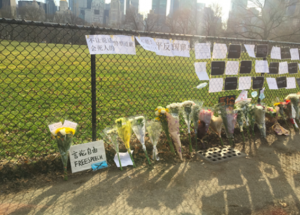
Figure 1. Memorial for Li Wenliang, Sheep Meadow in Central Park, New York, February 9th, 2020. Photo provided by the author.
After March 7, events seemed to accelerate, further unveiling lies, alongside vulnerability, rage and confusion. A wound was suddenly ripped open, resulting in a flowing river of blood. Sad news stories kept coming, one after another, from Italy, Iran, the UK, the Philippines, and the rest of the world. Airlines were collapsing. Small businesses were at risk. Middle-class and working-class people started worrying about their future. All of a sudden, restaurant workers, airline employees, and gig workers were on the verge of being laid off. Immigrants and undocumented residents without families were most at risk. More than ever, we learned that our social welfare was deeply tied to our immigration status in this country. We wondered, how are we going to collectively survive other crises, such as the huge environmental shifts and resulting displacements, that will come in the future?
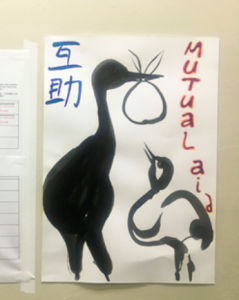
Figure 2. A mutual aid poster on display at 172 Henry Street in Chinatown, New York, April 25th, 2020. Photo provided by the author.
For a short time, New York became a site of discombobulation, isolation, and helplessness. The city was pale and empty. Workers in the arts, who were lucky enough to keep their jobs, started to work from home. Essential workers, including doctors, nurses, delivery drivers, and home caretakers, were getting off from work shattered. After a period of panic, some artists started to break out of their isolation and regather in small volunteer communities, helping food pantries, protesting against evictions, and organizing mask donations, all built upon the principle of Mutual Aid Community Agreements: “We Keep Us Safe” (Fig. 2).
The city began returning, bursting with idealistic energy. Most precious for the Asia Art Archive in America during this time has been the support and care we have been able to provide for each other. Invaluable weekly virtual meetings helped us stay connected and in dialogue, discussing together our changing thoughts throughout this critical time.
Our research collection, the Joan Lebold Cohen Archive Phase II was successfully launched online in the height of lockdown, on April 1. Three years after the launch of Phase I, the trips Joan Cohen took to China from the 1970s–2000s are finally fully available to explore and learn from: 16,453 color photographs of artists, artworks, studios, academies, exhibitions and scenes of everyday life. These images of a past world travelled through the years and arrived at a moment when nations are drifting apart towards isolation. In the midst of reimagining a new spatiotemporal organization of the world, the looks, smiles, and gestures Joan captured on film brought to mind air and light (Fig. 3).
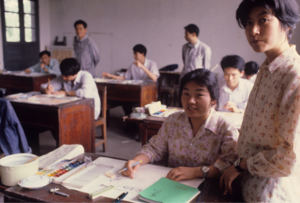
Figure 3. Students in art and design class at Guangzhou Art Academy, Guangzhou, China, 1980. Photo: Joan Lebold Cohen Archive, Asia Art Archive, NY
In Beijing and Hong Kong before returning to New York in February, I was saddened to have witnessed the virus hitting the collective body multiple times. Working through the Joan Lebold Cohen Archive was a healing process, to imagine myself traveling in time and giving light to the gaps of multiple pasts. I want to end here with a quote from the essay Solidarity/Susceptibility by Judith Butler (Social Text, 2018), from her remarks on José Muñoz, the Cuban American scholar of performance and queer studies who died in 2013, as an inspiration to think about archives and the new imaginary: “The potentialities that appear as rips and tears in the otherwise seamless future of no future for those abandoned by progress are immanent and furtive possibilities within the present, indicating that this time is also another time, and always has been; it opens toward a past and a future even when, politically, the force of oblivion seeks to cover over those very openings.”
Erasures and Experiments: The COVID-19 Story in India, Noopur Desai, Researcher, Asia Art Archive, India
Today, we are experiencing an unprecedented moment as we brave the COVID-19 crisis across the world. In India, the situation is complex, similar to many parts of the world, bearing multiple strands, with implications for various aspects of our lives. When the pandemic hit India in March of this year, though early cases were found in January, the country was going through a massive political movement demanding democratic constitutional rights. The announcement of a sudden lockdown across the country on March 22 resulted in the suspension of all social gatherings including, most importantly, the ongoing nationwide sit-in protests against the Citizenship Amendment Act and the National Register of Citizens in various cities and towns.
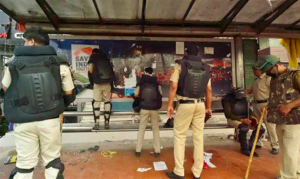
Figure 1. Graffiti and artworks at protest sites, removed by the police during the lockdown, “The Logical Indian,” March 27, 2020. Photo: Hindustan Times
In the midst of panic and uncertainty in conjunction with the mismanagement of the crisis, the previous two months began to appear a distant past with the erasure of politics and the transformation of public space during the lockdown. In effect, the public space was rather transformed, with images of a mass exodus as hundreds of thousands of migrant workers journeyed home from big cities after the closing down of markets, manufacturing units, and various laborer jobs. Combined with a sense of amnesia brought on by the spectacle surrounding the pandemic, the government actions (mis)used the situation to crackdown on dissenting voices, either by arresting social and political activists, defacing artworks and graffiti at protest sites (Fig. 1), or by exercising certain restrictions on media. Taken together these actions have highlighted the systemic inequality and repressive nature of the current regime.
Surrounded by this grave situation, various arts organizations, artists, and museums have had to reconfigure themselves. Several exhibitions and programs were canceled or postponed, and young arts practitioners moved back to their birthplaces or are struggling to survive in metropolitan centers like Delhi or Mumbai. Responding to the severity of the crisis, many arts practitioners and arts organizations have stepped up to create support systems, including grants for young artists, online displays of artworks, and the formation of chain-systems, wherein artists buy each other’s work. The arts community also created online auctions and other fundraising events to contribute to the relief work for migrant workers and other vulnerable populations.
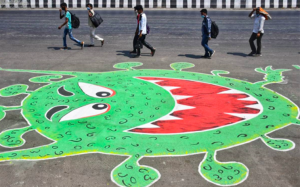
Figure 2. Migrant workers walk in front of a coronavirus graffiti in Mumbai, May 14, 2020. Photo: The Hindu
Physical distancing quickly resulted in digital proximity with the arrival of webinars and online exhibitions organized by museums and galleries, although the graph of the webinars seems to be “flattening” in recent times! However, the digital world has become an intrinsic part of our lives, whether it is through virtual studio visits, webinars, and simulated gallery tours or by creating online resources for teaching and learning. In terms of art education, studio-based practice has been replaced by experimentation with the digital, though only at a few schools, as most of them do not have the resources to run online programs. Nevertheless, there have been important instances where students have used digital platforms to organize their annual exhibitions, which are required for graduation, and which for the most part have not been able to take place physically. Though physical space is crucial in contemporary art practice, this intense effort to use alternative platforms has certainly paved the way for forming new aesthetic possibilities.
While we all are grappling with this strange time, at Asia Art Archive in India we continue building our online research collections and shaping new projects. As an online platform, we have been able to continue several aspects of our work by sharing digital resources and programming via our website. Despite this, we have also faced challenges in light of changing situations. Though our collections are available online, the groundwork to build those collections requires in-person visits to archives and libraries, access to review personal archives, resources to digitize the documents, and programs to introduce the archival collections; most of these activities have been brought to a halt for now. In the meantime, we are maintaining our spirits by planning and carrying out whatever aspects of our work we can, keeping in mind the need for physical distancing. At the same we are recalibrating our working methods as we venture into the “new normal.”
CWA Picks for November 2020
posted by Allison Walters — November 13, 2020
November CWA Picks
November Picks from the Committee on Women in the Arts celebrate an array of exhibitions and public artworks featuring feminist and womxn artists in this transitional time. As always, our global highlights are informed by shows and events that explore social justice issues and intersectional feminism.
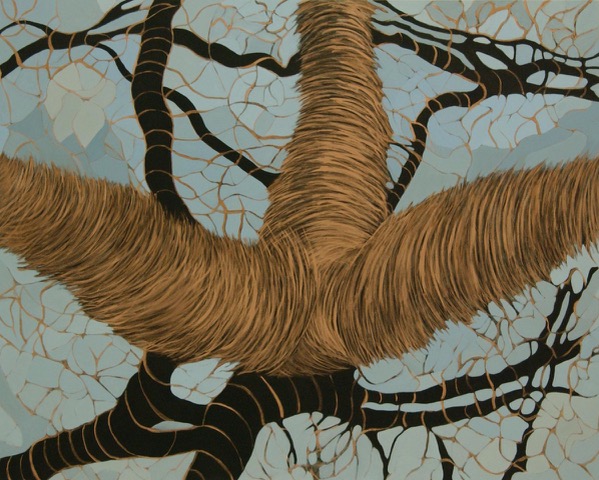
© Eunice Golden 2006
“Metamorphosis #17” Acrylic on Canvas
48″ x 60″
- The Shape Of Play: Sari Carel’s recent public art installation at Waterfront Park in Boston pushes the boundaries of modern art, sound art, childhood and play through this heavily researched and process oriented, interactive work. For more information on the piece, you can also visit here and here.
- Eunice Golden: Metamorphosis: SAPAR Contemporary presents the gallery’s first exhibition devoted to renowned artist and radical feminist Eunice Golden’s (b. 1927, Brooklyn) late paintings and prints, and an opportunity to celebrate her enduring contributions to feminism and activism since the earliest years of the feminist art movement. The exhibition features her recent large-scale series, Metamorphosis (2003-2007) and Flora (2009), evoking her early sexual bodyscapes and exploring through gestural expanse of color, rapid brushwork, and hypnotic patterning, contemporary issues around ecological uncertainties and challenges. Through Nov. 28, 2020.
- Feminist perspectives in artistic productions and art theories: The Artium Museum 2-day course directed by Directed by Xabier Arakistain, art curator, and Lourdes Méndez, professor of anthropology of art at the UPV / EHU, includes a variety of speakers around contributions of feminist artists and theorists of art and the theoretical and political problems that must be faced today in order to continue developing and disseminating art and knowledge free from androcentric and ethnocentric biases. Nov. 14-15, 2020.
- Jo Ractliffe: DRIVES: Chicago Art Institute presents the first survey of South African photographer Jo Ractliffe (b. 1961), featuring more than 100 large scale color prints, video and documentary photographs spanning her career, including dreamlike photographs made in the 1990s of the port city of Durban and on a cross-country road trip, the unsettling installation N1 Incident/End of Time(1997/99), and much more. Through April 26, 2021.
- Baltimore Museum of Art presents several current exhibitions centered on women artists and ideas. Perfect Power: Motherhood and African Art includes 40 representing the power of African mothers and maternal imagery, through Jan. 17, 2021. Candice Breitz: Too Long, Didn’t Read features two muiltichannel video installations by the South-African born artist on privilege, visibility and the fetishizing of celebrity, through Jan. 10, 2021. Shinique Smith: Grace Stands Beside, is a new deity-like figurative sculpture by the artist who was raised in Baltimore, using Baltimore resident’s donated fabric to exude, said the artist “a complex state of being that Black people and other who have endured tragic prejudice have embodied to survive and rise beyond,” through Jan. 3, 2021. SHAN Wallace: 410 is an immersive collaged environment installation by the Baltimore based artist SHAN Wallace, through Jan. 3, 2021. Other notable exhibits include: Katharina Grosse: Is It You?, Valerie Maynard: Lost and Found; Ana Mendieta: Blood Inside Outside; Howardena Pindell: Free, White and 21; Jo Small: Flying with Remnant Wings; Elissa Blount Moorhead and Bradford Young: Back and Song; all through Jan. 3, 2021.
International News: Letters from Asia Art Archive Under Lockdown (Part I)
posted by Allison Walters — November 10, 2020
The following article was written in response to a call for submissions by CAA’s International Committee. It is by John Tain, Congyang Xie, Michelle Wong, Cici Wu, and Noopur Desai, all researchers at Asia Art Archive.
Introduction, John Tain, Head of Research, Asia Art Archive
In the first few months of this year, one thing that became clear was how deeply divided the world remained and remains, even as globalization brought us all closer physically and virtually. There have been of course the many overt racist acts around the world, and also the less visible but no less insidious effects of structural racism on individuals and communities of color. There also remains plain ignorance reinforced by geography. In long distance calls and video meetings, it became clear that what people across Asia recognized right away as a cataclysmic life-or-death disaster remained literally and figuratively a faraway concern for many people in the United States and Europe—until it wasn’t anymore.
At Asia Art Archive (AAA), we have seen the drama unfolding firsthand in both Asia and North America. Our colleagues in Shanghai went into lockdown almost as soon as the news came out of Wuhan, with our main office in Hong Kong soon to follow. For those first few weeks, outpourings of concern, sympathy, and sometimes curiosity accompanied the daily news and dreaded case tallies. Then, as the pandemic spread, it was our colleagues in New York and then New Delhi who were hit, along with the rest of the world, and it became our turn to send support and supplies when possible. We had already been in the habit of meeting regularly on Zoom as a way to work across distances, but throughout these months, talking with one other online became about more than work. It became a way to bridge the chasms keeping us apart all the more now. It is in the spirit of those conversations that I have asked my colleagues to share their thoughts, as reminders that whatever the disparities, we must deal with this together.
The Pandemic and Politics, Congyang Xie, Research Associate, Asia Art Archive, Shanghai
In early February, two weeks after the shutdown of Wuhan due to the outbreak of the coronavirus, an article was published by Slovenian philosopher Slavoj Žižek titled “Clear Racist Element to Hysteria over New Coronavirus.” Translated into Chinese and circulated through the social media platform WeChat, it quickly became one of the most widely shared texts among contemporary art practitioners in Mainland China. Žižek, who has built a large readership in China over the last decade, began by saying that “Some of us, including myself, would secretly love to be in China’s Wuhan right now, experiencing a real-life, post-apocalyptic movie set.” (https://www.rt.com/op-ed/479970-coronavirus-china-wuhan-hysteria-racist/)
More challenging statements followed. Unsurprisingly, there were all kinds of reactions within the art world, which amplified when more articles were published and circulated via WeChat by other Western thinkers who are more or less known to Chinese art practitioners, including Jean-Luc Nancy, Jacques Rancière, and especially Giorgio Agamben (Fig. 1). But the controversies around Žižek were particularly interesting. If Žižek’s text, as many have pointed out, disregarded the local context in China, the reading and sharing of the article in Chinese was also decontextualizing. The (re-)awareness of the very existence of intellectual borders that so many people tried hard to ignore may be one of the by-products of COVID-19.
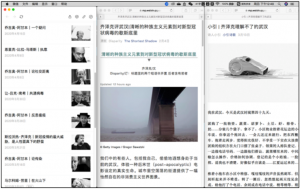
Figure 1. Left: A WeChat account publishing translated articles by various Western philosophers regarding the pandemic. Middle: Screenshot of Žižek’s article published in Chinese. Right: Screenshot of an article by Chinese poet Xiao Yin, titled “The Wuhan City That Žižek Cannot Understand”. Photo provided by the author.
Reading the text in a literal way, Žižek’s fiercest critics denounced the philosopher as naïve, if not delusional, for saying the situation in Wuhan was desirable, for ignoring the real tragedy in Wuhan, and for being indifferent to the dead and to those who were still suffering. Such opinion is based upon a humanistic attitude. The most extreme camp, however, went so far as to reach a nationalist point of view, concluding that Westerners never understand what is happening in China, and that Western theories are irrelevant and not applicable to China’s problems.
Another group of critics, non-nationalists, with a more liberal mindset, were thus highly attentive to Žižek’s call for “a new form of what was once called Communism.” Based on modern and contemporary history of China, this group considers Communism as just the flip side of the coin of authoritarianism. Taking individual freedom as a priority, this group worried that the activity-monitoring technologies used by the government in the name of containing the epidemic would eventually normalize and strengthen total governmental control over society, even after the epidemic ends.
This critical attitude towards authority was shared by a third group of people, who would agree at least partially with Žižek, citing his words that “If there were people in China who attempted to downplay epidemics, they should be ashamed.” In fact, during the first days of the coronavirus outbreak, transparency from authorities was the strongest demand from all of China’s social groups. The protest reached a peak when Li Wenliang, the whistleblower doctor who was forced to keep silent by authorities, was reported to have passed away from the deadly disease on February 7. That night, lit-candle emojis were all over social media. In response to the event, artist Zhang Peili designed a minimalist set of two T-shirts, which are worn frequently by artists and visitors to exhibitions (Fig. 2).
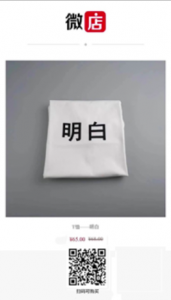
Figure 2. Online shop selling T-shirt designed by Zhang Peili. The text means “I understand.” Photo provided by the author.
The debates highlight the ideological conflicts in China that have only intensified under the pandemic, though more space would be needed to map the full spectrum of opinions. Perhaps what makes Žižek’s text so appealing to art practitioners in China in the first place is the claim that “there is, however, an unexpected emancipatory prospect hidden in this nightmarish vision,” even if people may have (mis)understood it in a thousand different ways.
Separate yet Together, Michelle Wong, former Researcher, Asia Art Archive, Hong Kong
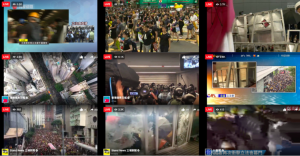
Figure 1. Screenshot of news livestream, July 1, 2020. Photo provided by the author.
One evening in March 2020, when Hong Kong’s first wave of COVID-19 cases was subsiding, we sat in a friend’s studio to look at the image archive of an artist-run space. “100 Square Feet Park,” or the Park, as we affectionately call it, was once a storefront on Lai Chi Kok Road, facing busy traffic. The image we were looking at was of a documentary exhibition from the Umbrella Movement of 2014. A monitor was placed on a table facing the street level. Pedestrians walking by wondered whether the images shown in the monitor were live or documentary images. It struck me at that 2020 moment, as we looked at the image five years on, that I had forgotten how it felt when livestreaming news—of marches, of roads puffing with smoke, of sparks flying out from long tubes, of people in all sorts of uniforms running—was not yet a norm. I remember an inexplicably overwhelming feeling of looking at the nine images on the split-screen livestreaming for the first time, and I thought my simmering anger would rise to the boiling point if I saw one more Instagram post that attempted to theorize this over-mediation.
For some time now I have pondered the morbidity that is part and parcel of my vocation as a researcher at AAA. It is only half a joke when I describe my job as “talking to old(er) people and working on dead people stuff”. On various occasions I have described archives as haunted and haunting, trains for zombies, and repositories for art that could be undead. I still think about these things when I peer and squint at my computer screen while on Zoom/Jitsi/Skype. During the time leading up to the pandemic, and perhaps also during it (i.e. now), I think often about a generation of practitioners, many of them friends and colleagues who I have met through my work at AAA. I think of how these people, myself included, have knowingly or unknowingly committed ourselves to remembering other people’s lives. Everyone who tells stories of other people’s lives, in this case through dealing with their archives, is learning how to do so along the way, much like writers learning how to write. And as we remember these lives and tell these stories, our stories can become entangled with theirs. Sometimes, it is nice to know you can choose not to do it alone.
Affiliated Society News: November 2020
posted by Allison Walters — November 06, 2020
Affiliated Society News shares the new and exciting things CAA’s affiliated organizations are working on including activities, awards, publications, conferences, and exhibitions.
Interested in becoming an Affiliated Society? Learn more here.
American Institute for Conservation
Conservators around the world will answer questions about their work on Ask a Conservator Day, November 18th, 2020. We hold Ask a Conservator day in November in remembrance of the flooding of Florence on November 4th, 1966, which damaged priceless cultural heritage. However, in response to the catastrophe, incredible efforts were made—and are still being undertaken—to conserve the items impacted by the flood.
Ask a Conservator Day follows in the spirit of that international collaboration and exchange of knowledge. We celebrate the growth of the field inspired by the response to the flood through this opportunity for people to learn about conservation and preservation directly from conservators on social media.
Ask questions on subjects, mediums, and topics that interest you, or see if your favorite cultural heritage institution is participating. Last year’s subjects included discussion on favorite projects, career advice, everything—including grossest collection item or condition issue encountered. Use the hashtag #AskAConservator on social media platforms (such as Facebook, Twitter, LinkedIn, and Instagram) to catch up with previous discussion and join in the conversation on the 18th!
Association of Print Scholars
The Feminist Art Project
Rejoinder Call for Submissions — Climate in Crisis
“Climate change,” as former UN High Commissioner for Human Rights Mary Robinson so astutely notes, “requires a feminist solution.” Global heating is causing rising sea levels, extreme weather events, and the circulation of new pathogens. It impacts economically, socially, and politically marginalized people and communities most severely. Women and children, the majority of the world’s poor, are already disproportionately burdened by its effects. In the Global North, the climate breakdown compounds the environmental racism that many communities of color already experience. Unless the richer, whiter nations of the Global North make a seismic shift in their priorities, experts predict that the Global South will bear the brunt of the climate emergency, with dire consequences inevitable.
This issue of Rejoinder will address the climate crisis in our midst. Submissions (including essays, commentary, criticism, fiction, poetry, and artwork) should address this theme from feminist, queer, social and racial justice-inspired perspectives. We particularly welcome contributions at the intersection of scholarship and activism. For manuscript preparation details, please visit: https://irw.rutgers.edu/about-rejoinder. Rejoinder is an online journal published by the Institute for Research on Women at Rutgers University in partnership with The Feminist Art Project. Please send completed written work (2,000-2,500 words max), jpegs of artwork, and short bios to the editor, Sarah Tobias (stobias@rutgers.edu) by January 6, 2021.
Society for Architectural Historians
The Call for Session Proposals for the Society of Architectural Historians’ 2022 Annual International Conference in Pittsburgh has opened. Please visit the call here: https://www.sah.org/2022/call-for-sessions
Society of Contemporary Art Historians (SCAH)
Announcing New Initiatives of the Society of Contemporary Art Historians
The Society of Contemporary Art Historians (SCAH), an affiliate society of the College Art Association, is proud to announce the launch of several new projects, publications, and initiatives aimed at promoting equitable and transcultural histories of contemporary art.
Online Programming
Following the widespread shift to online programming in the wake of Covid-19, SCAH presented several virtual programs that were well attended by an international audience. These included a screening of films by artist Nancy Holt followed by a conversation between Kirsten Swenson and Rebecca Uchill; a conversation between video artists Meriem Bennani, Orian Barki, and Marisa Olson; and the panel discussion “Toward an Anti-Racist Contemporary Art History,” featuring the art and architectural historians and curators Amy K. Hamlin, Christina Knight, Ana María León, Alpesh Kantilal Patel, and Ellen Y. Tani. Archived videos from these events are available to view on the SCAH website. A follow-up anti-racist contemporary art history bibliography edit-a-thon is scheduled for Friday, December 4th, 2020 and will be complemented by a related workshop to be scheduled in January 2021. Our 2021 CAA panel focuses on the subject of “Aggregators and Agitators” and will be announced alongside the annual conference’s schedule.
New SCAH Publication: Foreign Language Index
SCAH has published the inaugural issue of a new open-access publication, Foreign Language Index (FLI), which is available here via the SCAH website. This annual journal comprises abstracts and commentary on recent non-anglophone contemporary art history scholarship. The first issue compiles entries by international contributors working across sixteen languages: Albanian, Arabic, Chinese, Danish, French, German, Italian, Japanese, Korean, Latvian, Polish, Russian, Spanish, Turkish, Ukrainian, and Vietnamese.
Curatorial Opportunity
In an effort to respond quickly to diminished exhibition opportunities for artists in the wake of Covid-19, SCAH turned its website over to current and recent graduates of the MFA Program in Art Practice at Stanford University. Images of their work populates multiple pages throughout the organization’s presence; more information about the artists can be found here. Moving forward, SCAH’s website will continue to serve as a rotating online exhibition platform. Accordingly, SCAH currently seeks candidates to fill a newly established curator-at-large position on its executive board. Position details can be found here.
Membership
The organization recently revised its membership categories, making it easy to join SCAH at varying levels of support. Members can now access more information about members’ ongoing projects and connect with others in the SCAH community through the site.
SECAC
2020 Conference Updates
VCUarts will host SECAC 2020 from November 30 to December 11. The fully virtual conference will have over 80 breakout sessions, plenary events, and networking opportunities, including:
- Keynote Lecture by Valerie Cassel Oliver, Curator of Contemporary Art at the Virginia Museum of Fine Arts
- Virtual Juried Exhibition at the Virtual Anderson at VCUarts, with remarks and Best-in-Show awards presented by Juror Sarah Eckhardt, Associate Curator of Contemporary Art at the Virginia Museum of Fine Arts
- Racial Justice Town Hall hosted by the SECAC Equity, Diversity and Inclusion Committee and facilitated by Marian Vassar
- SECAC Mentorship Program
To register for the conference, please visit: https://secac.secure-platform.com/a/solicitations/10/home
The preliminary schedule is now available on our virtual conference platform:
https://secac.secure-platform.com/a/solicitations/9/sessiongallery/schedule
Questions regarding the conference should be directed to Conference Director Carly Phinizy, secac2020@vcu.edu.
Call for Applications: SECAC Equity, Diversity, and Inclusion Awards
To recognize the exceptional work of those ndividuals historically underrepresented in SECAC, higher education, and arts institutions, applications are now being accepted for Equity, Diversity, and Inclusion (EDI) Awards, which cover the cost of conference registration plus two years of SECAC membership for five recipients.
Qualifications:
- Those who have been underrepresented in their field for any reason, but especially due to race, are welcomed to apply.
- Preference is given to SECAC 2020 selected session chairs, presenters, or Juried Exhibition artists who are current members.
To Apply:
Submit a brief CV (3 pages max) with full contact information and a statement (250 words max) explaining how your participation furthers the goals of this award to SECACaction@gmail.com.
Deadline: 11/13/2020*
*Those selected for this award must complete membership and conference registration paperwork with SECAC prior to receiving funding.
William Morris Society in the United States
The William Morris Society in the United States strives to publicize the life and work of William Morris and his associates. Members receive the print newsletter, Useful & Beautiful and the biannual Journal of William Morris Studies, along with a digital version of the William Morris Magazine from London. The Society offers the annual Joseph R. Dunlap Memorial Fellowship and its activities encompass lectures, conferences, social gatherings, and site visits.
The society will celebrate its fiftieth anniversary in 2021. We shall be presenting panels (virtually) at the Modern Language Association Annual Convention in January on the topics of “Morris and Biography: Letters Archives, Artifacts” and “Revisiting William Morris and the Arts and Crafts: Reception and Influence,” the second sponsored with the Forums on Book History, Print Cultures, and Lexicography. Our session at CAA, entitled “William Morris Today,” will hold its live discussion on Saturday, February 13 at 6:00pm. We will also have our business meeting and organize a virtual visit to the Grolier Club, where librarian Meghan Constantinou will show off the club’s remarkable Morris and private press-related related holdings. Visit our website for further information: www.morrissociety.org.
In the works are a new website, online presentations by Society members (two on collecting Morris’s books), and participation in worldwide exhibitions and a UK symposium to mark the 130th anniversary of the founding of the Kelmscott Press.
Women and Voter Suppression: A Roundtable Discussion
posted by Allison Walters — November 02, 2020
In honor of Election Day, we present a roundtable discussion from the 108th CAA Annual Conference in Chicago on women and voter suppression. Sponsored by the Committee on Women in the Arts, this session took place on February 13, 2020.
Chairs: Sally Brown, West Virginia University; Liz Kim, Texas A&M University-Kingsville
Discussants: Karen Mary Davalos, University of Minnesota; Jo-Ann Morgan; Marshall Reese, of LigoranoReese, Independent Artists
This session considers how artists and scholars have explored voter suppression as a subject matter across historical and cultural boundaries with a view toward examining the present. In the US, voter suppression targets particularly women who are black, immigrant, elderly, young, low-income and disabled, keeping them from the polls. Since 2010, 25 states have placed new restrictions that make the exercise of fundamental voting rights harder. This change has been exacerbated by the 2013 Supreme Court ruling that struck down a key provision in the 1965 Voting Rights Act, enabling states to institute discriminatory voting laws. The legacy of Jim Crow laws persists through these recent shifts in policy, while disproportionally affecting growing voter groups such as Latino/a voters in the US. In these political times, historical lessons can be drawn from the past, in the ways women have collectively fought against political silencing. Our roundtable panelists address and illuminate how artists and activists work and have worked creatively to resist and fight voter suppression for women, as well as reflect on broader political suppression issues for women voters. From the Chicana feminist art of the 1970s, to the imagery of the revolutionary women of the Black Power Movement, to public art interventions in the Trump era, this session aims to take a broad and reflective approach to this politically urgent topic.


